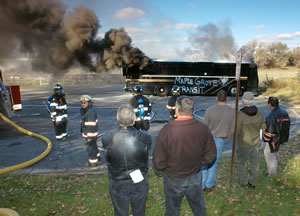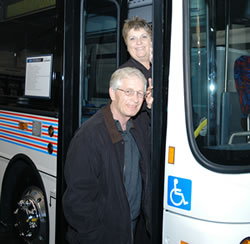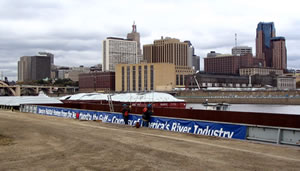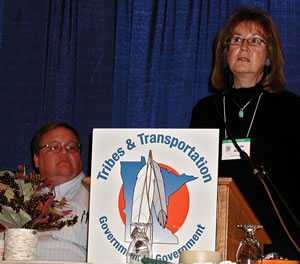 |
 |
|
 |
Funding, safety among topics highlighted at annual transit conference |
 |
 |
 |
|
Members of the Bloomington Fire Department demonstrate the susceptibility of buses to fire at the Minnesota Public Transit conference. Photo by David Gonzalez
|
Participants at the 31st annual Minnesota Public Transit conference heard some welcome news—the recently approved federal legislation grants increased funding for Minnesota’s transit programs.
Tom Yedinak, an official with the American Public Transit Association, told the participants at the general session that SAFETEA-LU, the six-year federal transportation funding legislation, will raise funding levels significantly in fiscal years 2005 through 2009.
For example, he said, funding will increase between four percent to eight percent for urban transit systems.
In addition, Minnesota will receive earmarked funds for buses and bus-related facilities; $4 million for the Red Rock (Hastings to St. Paul), Rush Line (St. Paul to Pine County) and Central (between the Minneapolis and St. Paul downtowns) transit corridors, and $80 million for the North Star Commuter rail line between Big Lake and Minneapolis.
Participants also heard from Rachel Simon, author of “Riding the Bus with my Sister.” Simon’s book chronicles the year she spent riding with her developmentally delayed sister and the web of connections and support she built during her daily bus commutes.
Simon told the conference that experience made clear to her the role transit plays in the health and vitality of individuals and their communities.
She spoke of the benefits of transit for communities and how passengers, no matter what their station in life or work may be, become equals as bus riders, said Micky Gutzmann, Office of Transit and conference chair.
Gutzmann said the conference focused attention on critical issues in transit such as funding, driver retention, using technology, marketing and safety.
One breakout session, led by the Bloomington Fire Department, demonstrated the susceptibility of buses to fire. Gutzmann said it took several minutes before an engine fire created visible flames and posed a risk to the passenger compartment.
However, it took only one minute after one seat was ignited for the fire to produce enough smoke that a passenger would not have been able to see out the windows.
Within in three minutes, she said, anyone still on board would have died from fire or smoke inhalation.
“There are more regulations that cover fire resistance on aircraft, trains and school buses, but a limited amount that cover transit buses,” she said. “This demonstration shows that we have a lot of work yet to do in the area of bus safety and passenger protection.”
By Craig Wilkins
|
back

|
 |
Construction crews wrap up projects. . . |
 |
 |
Dozens of highway improvement projects Mn/DOT completed this year will ease the travel demands on commuters, shippers, business travelers and other state highway system users. The projects include new interchanges, road reconstruction, new bridges and myriad safety improvements.
“The projects we’ve completed this summer and fall will significantly improve the highway system and Minnesota’s ability to move people and goods,” said Lt Gov./Commissioner Carol Molnau. “By using processes such as design-build, new materials and the hard work of Mn/DOT people and our contractors, we’ve accomplished a lot.”
Northern Minnesota
People driving north from the Twin Cities metropolitan area and other locations will experience a safer, less stressful trip on Hwy 371 where an additional section of the roadway was expanded from two to four lanes between Little Falls and Morrison County Road 46 near Camp Ripley.
A new interchange that connects Hwy 10 and Clay County Road 32 near Hawley will open in early November. The project was done by using the “design-build” process which compresses the time needed to design, award a contract and build a project, often reducing traffic disruptions and lowering overall costs.
A 10-mile section of Hwy 71 south of Bemidji was resurfaced. Near Upper Red Lake, a new bridge that uses pre-fabricated concrete deck beams to speed construction was completed to carry Hwy 72 over the Tamarac River.
In northeastern Minnesota, the southbound lanes of Hwy 53 between Cotton and Independence were rebuilt. The first half of rebuilding Hwy 53 (Trinity Road) in Duluth was completed this year. The second half will be finished in 2006.
Twin Cities metro area
In the Twin Cities metropolitan area, newly rebuilt highway segments include those on Hwy 100, Hwy 169 and Interstate 494.
Hwy 100 was rebuilt between Glenwood Avenue in Golden Valley and Brooklyn Boulevard in Brooklyn Park to increase traffic capacity and reduce traffic conflicts. The five-mile-long project started in 2000. A new interchange connecting Hwy 169, Anderson Lakes Parkway and the Bloomington Ferry Road in Bloomington was completed to replace a signalized intersection.
The I-494 project expanded the freeway from two lanes in each direction to three between Hwy 5 in Eden Prairie and France Avenue in Bloomington. The project is the first stage of Mn/DOT’s plan to expand the I-494/I-694 freeway ring around the Twin Cities to meet spiraling transportation demands in the region.
Southern Minnesota
In southwestern Minnesota between Willmar and New London, motorists will find a safer, faster trip on the newly rebuilt and expanded Hwy 23. In Rochester, the reconstruction of an 11-mile section of Hwy 52 through the city will reduce congestion, increase safety and improve traffic flow.
New Ulm residents and motorists passing through on Hwy 14 (Broadway Street) will see a more attractive and less congested route in the city’s downtown and its outskirts.
By Craig Wilkins
|
back

|
 |
. . . as snowplow operators rev up for winter |
 |
 |
Even as crews statewide wind-down construction projects amid warmer than average temperatures, thoughts already are turning to the next big challenge for Mn/DOT: the snow and ice season.
The department held its annual snow and ice season media kick-off Nov. 1 in Mendota Heights to raise awareness among motorists that they need to use caution when driving in snow and ice conditions and need to give snowplow operators room to work.
More than 1,500 Mn/DOT snowplow operators will climb into 800 snowplows to clear the 12,000 miles of state roadway this winter.
At the news conference, some reporters questioned the use of snowplow operators whose primary job is not maintenance.
"We don't put drivers out on the road until we know that they've been trained," said Bob Winter, director of district operations. He reminded reporters that all snowplow drivers are required to have a commercial driver's license.
Mn/DOT staff at the news conference gave an overview of the departrment's snow and ice technology and operations.
Most Mn/DOT trucks are equipped with onboard equipment that sprays the multi-ton loads of sand and salt with brine or other liquid chemicals that jump-start the salt’s snow-melting capability and helps the sand and salt stick to the road surface.
To coordinate the snowplowing effort, Mn/DOT uses radio communications that link snowplows with each other and with a supervisor. Managers can move plows to where they are most needed or divert snowplows to support law enforcement agencies in case of a crash or other highway emergency.
Maintenance supervisors can choose, for example, to use anti-icing chemicals before a winter storm begins to keep ice and snow from bonding with the pavement surface. Or, if a storm has started, the best choice might be to use de-icing chemicals in addition to plowing to remove snow and ice from the roadways.
“We have dedicated, hard-working snowplow operators in Mn/DOT,” said Lt. Gov./Commissioner Carol Molnau. “As they have in the past, they will do their best to keep the roadways clear and safe. Those of us driving in winter conditions need to use caution, drive safely and give the snowplow a chance to work. We urge motorists to stay back, and stay alive.”
Click here for more information about winter work zone safety and Winter Safety Awareness Week, Nov. 7-11.
|
back

|
 |
Transit buses play key role in emergency evacuation at Mankato |
 |
 |
 |
|
The planning of folks like Janice Klassen, Mankato/District 7’s transit project manager, and Jerry Byers, a supervisor with Mankato’s transit system, paid off Oct. 20 when 143 people in an elder care residence were evacuated because a tanker carrying anhydrous ammonia overturned on Hwy 169. Photo by David Gonzalez |
After a tanker truck carrying anhydrous ammonia overturned in Mankato on Oct. 20, Mn/DOT, area law enforcement agencies and firefighters put their well-rehearsed and often-practiced response smoothly into gear.
At the same time, another emergency response tactic kicked in as well—using Mankato’s transit buses to evacuate a residence for elders about one mile from the incident on Hwy 169.
Officials ordered the evacuation because righting the tanker might have caused a release of the highly caustic ammonia.
In less than two hours, back-up drivers were contacted, buses fueled, plans finalized and the residents moved to a safe location.
Working with Janice Klassen, Mankato/District 7’s transit project manager, the Mankato Heartland Express and other transit providers updated plans last year to use their buses in emergency situations.
The planning paid off. A total of 143 residents were transferred to pre-planned locations including a hospital and the Mankato Civic Center. Of the residents evacuated, 55 use wheelchairs.
Klassen said the city’s low-floor buses made it easy to move residents who use wheelchairs into the front of the bus, transfer them to seats and then take their wheelchairs out the bus’s rear exit.
No ammonia leakage occurred, but Klassen said the incident shows the value of planning and using resources such as transit in emergency situations.
Klassen said nine of the buses came from the city’s transit service and four were loaned by a social services agency.
Jerry Byers, a supervisor with the city’s transit system, said the Red Cross and Salvation Army provided services to the residents until they returned home about 10 p.m.
“We’ll meet again next week to review how this incident response went, update our plan and see how we can improve our response in the future,” he said.
By Craig Wilkins
|
back

|
 |
Habitat for Humanity ships four new homes from Minnesota to Louisiana |
 |
 |
 |
|
Downtown St. Paul serves as a backdrop for a barge docked and waiting to have four Habitat for Humanity homes loaded into its cargo hatch for shipment to Louisiana. Photo by Dick Lambert |
In the early hours of Oct. 24 in Upper Landing Park in downtown St. Paul, Habitat for Humanity volunteers put the finishing touches on four homes that were to be shipped later that day down the Mississippi River to Slidell, La., for victims of Hurricane Katrina.
NBC’s “Today Show,” as well as local TV stations, broadcast the event, which included Gov. Tim Pawlenty helping to raise the front wall of one of the homes.
Volunteers took apart and packed each house into a 40-foot-long metal container capable of holding about 20 tons of material. The containers were then loaded on to a barge, which the towboat M/V Virginia Ingram pushed down the Mississippi River, said Dick Lambert, Ports and Waterways director.
The homes were expected to arrive in Louisiana in about two weeks.
The containers and transportation services were volunteered by barge and towing industry companies at no cost to the hurricane relief effort.
 |
The 200-foot-long barge dwarfs the 40-foot-long containers, each holding the frame of a complete Habitat for Humanity home. A barge this size could hold 36 such containers, stacked three tiers high, three wide and four long. Photo by Dick Lambert |
Although the state does not have direct authority on the inland navigation system, Lambert said Mn/DOT supports it as an integral part of the transportation system in Minnesota.
“The container-on-barge transportation concept has not been alive in Minnesota for more than 40 years,” Lambert said. “This may be the start of a trend that started a few years ago on the lower Mississippi River. Mn/DOT is most interested since container-on-barge transport may help relieve some of the freight congestion on our roadways.”
Follow these links for more information:
|
back

|
 |
Tribes and Transportation Conference highlights partnership development |
 |
 |
 |
|
Linda Aitken, Mn/DOT's tribal liaison, speaks at the fourth annual Tribes and Transportation conference held this year in Mahnomen. Lee Berget, Detroit Lakes/District 4 transportation engineer, looks on. Photo by John Bray |
Native American tribal leaders met Oct. 26-27 with officials from all levels of government to discuss transportation planning and the formation of partnerships to improve the quality of life for all Minnesota residents.
The fourth annual conference was held this year at the Shooting Star Casino, Hotel and Event Center in Mahnomen, and gave tribal members and township, city, county, state and federal transportation leaders an opportunity to work on greater cooperation in future projects on the state’s transportation infrastructure.
Conference sessions focused on tribal transportation planning, funding sources, data collection and information sharing and coordinated transportation planning.
“This event is one in a series of historic meetings with Minnesota tribal members,” said Lt. Gov./ Commissioner Carol Molnau. “It was an excellent opportunity to talk about how we can work together to benefit all the residents of this state and ensure that all transportation systems and services work smoothly together.”
Participants were enthusiastic about the increased cooperation expected from the meetings.
“This important meeting provides a way to gather key transportation representatives from around the state together to talk about partnerships at a government-to-government level,” said Dr. Erma J. Vizenor, White Earth Tribal chairwoman.
Hosts for the event were the White Earth Band of Ojibwe, Mn/DOT’s District 4 (Detroit Lakes/Morris), and the Federal Highway Administration.
For more information about government-to-government partnerships, see the tribes and transportation Web site.
By Judy Jacobs, Detroit Lakes/District 4 public affairs coordinator
|
back

|
 |
November is decision time about insurance coverage, health assessments, flu shots |
 |
 |
Open Enrollment 2006 will be held from Nov. 3-16
Changing health care providers, increasing life insurance coverage and enrolling in pre-tax accounts are just a few of the options available to state employees during the annual Open Enrollment period, Nov. 3-16.
Choices available to state employees this year are:
- Changing health carriers
- Adding or dropping family health coverage
- Changing dental carriers and changing coverage (single or family)
- Increasing employee or spouse life insurance if they currently have it
- Enrolling in or increasing long term disability
- Enrolling in the 2006 pre-tax accounts
- Changing the disability elimination period in the Managers Income Protection Plan (for managers only)
Open Enrollment information is available on the Department of Employee Relations Web site, http://www.doer.state.mn.us/oe/.
Voluntary online health assessments are being offered
In addition, the state and health plan providers are offering employees the chance to complete an optional online health assessment during Open Enrollment. By taking advantage of this voluntary opportunity, employees can reduce their co-payments in 2006 by $5 per office visit for themselves and their covered dependents.
Participants will receive a personalized, confidential report, and depending upon the results, may be contacted by a health professional from their insurance provider to provide specific action plans for improving their health.
The health assessments are completed on secure health plan Web sites; neither Mn/DOT nor the Department of Employee Relations will be able to view or track any of the data.
Samples of the assessment forms, results reports, and read a Q & A about the assessments are located at http://www.doer.state.mn.us/HIP.htm. For more information on the health assessments, contact your health plan customer service.
Flu shots offered at work as part of 2005 “Fight the Flu” Campaign
Flu shots for state employees will be available through 178 clinics at state agency locations. By bringing a state employee health insurance identification card, employees are able to receive a flu shot at no out-of-pocket expense. Without an ID card, the flu shot will cost $20 (cash only).
Employees may attend any available state agency clinic to obtain a flu shot. To find an nearby agency flu shot clinic, visit: http://www.doer.state.mn.us/ei-sehpp/flu/flu.htm. Note: attending a clinic in another agency may require a check-in with that agency’s security.
All flu shot clinics are on a walk-in basis. Vaccinations also are available from employees’ primary care clinics or from Minute Clinics in the Twin Cities metro area, http://www.minuteclinic.com/.
Work time can be used to attend the clinic, with your supervisor’s approval.
|
back

|
 |
|
 |



